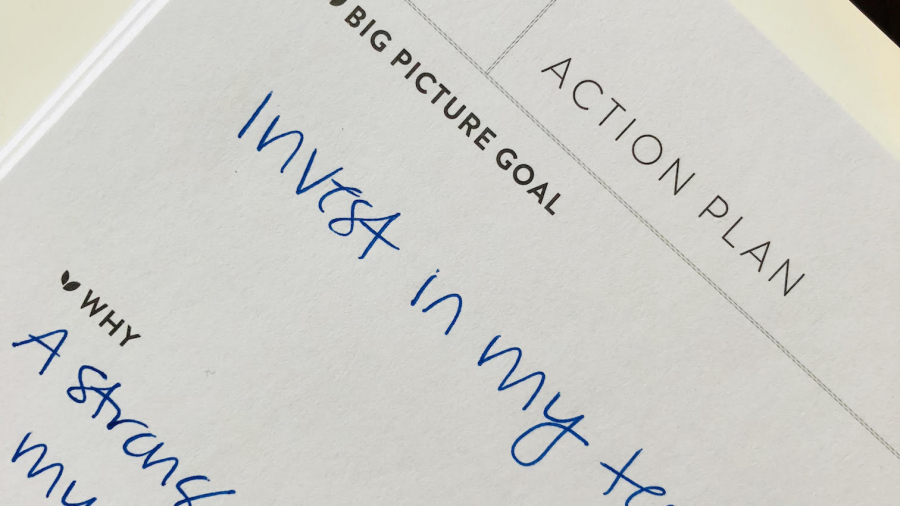I’m a mom of a brilliant, energetic toddler and the days can feel long. By the time she’s in bed at 7pm, I’m exhausted yet find myself watching The Office reruns and working on my laptop until 11pm or later. I finally fall into bed and, thanks to running my own business, don’t set an alarm for the next morning. My daughter’s monitor sits on my nightstand, about 12 inches from my head, so around 7am the next morning I’m awoken by her chatting to herself and moving around in her crib. I jump out of bed and have just enough time to put my contacts in, brush on a little makeup, and get dressed before her chatting escalates to screaming MOMMYYYYYY!
So from minute one, I’m on Mom Duty. Getting her dressed, bustling around the kitchen, playing the guessing game of what will she decide to eat today, and coloring endless pictures with crayons.
Some days I have childcare so I can work and by the time they show up at 9am, it feels as if the day should be halfway over already! I sit down at my desk to work and end up spending the first hour just clicking through my email, poking around on the internet, and just slowly getting into the swing of the workday.
Now, frankly, this probably doesn’t sound so terrible to some people. Maybe you’re out the door at 6:30am to drop your three kids at daycare, or maybe your toddler still doesn’t sleep well so you’ve been back and forth between your room and his four times last night.
I hear you.
But what we all have in common is that our days start off with a whirlwind of activity and by the time we have a moment to catch our breath, we almost don’t know what to do with ourselves. I felt like I was using my limited childcare inefficiently and my days and weeks lacked focus. Something had to give but I wasn’t sure what it was.
Earlier this year, my friend Susie posted an article about how getting up at 5am changed her life. She had read this book called The 5AM Club by Robin Sharma and claimed that this habit of getting up early made her calmer, gave her clarity, and helped her be more productive and healthier.
Wow!
It’s hard to believe that just an early wake-up call could provide those benefits.
I decided to give it a try, despite my skepticism, and just see what happened. The first few days I went to bed closer to 10pm and set my alarm for 5am. When the morning rolled around, I was so tired that I hit snooze until 6am and finally guilted myself into getting up.
Come on, Stephanie. You’ve done harder things than voluntarily waking up at 5am. Get UP.
I ignored myself at 5am morning after morning, but continued to get up at 6am. I realized that just because I wasn’t following someone else’s prescription exactly didn’t mean that I couldn’t get the benefits of getting up early. So I created my own 6am club!
Here is my usual morning routine:
- Get up at 6am
- Get showered and dressed with clothes laid out the night before in the bathroom
- Be downstairs making tea by 6:30am (and try not to scroll Instagram while the water is heating)
- Let the dog outside and feed him
- Sit down at my desk for journaling by 6:45am. Write a few pages on three things I’m grateful for and what I want to focus on that day (e.g. abundance, peace, joy, presence, etc)
- Meditate for 10 minutes
- Get another cup of tea and start working until I hear my daughter stirring
After six weeks of this routine almost daily, I can say with certainty that I’ve experienced significant changes in my life.
- I feel less anxiety. Sometimes if I’m feeling overwhelmed, usually by work, I feel a tightness in my chest and stomach. The 10 minutes of meditation I do each morning help me to shed this tightness and focus on my breathing. If you’re thinking, omg I could NOT sit still for 10 minutes, please know that I started six weeks ago with 2 minutes at a time and each time I was able to sit without going nuts, I bumped it up a minute the next day.
- I feel more focused. Even though I’m not journaling my to-do list each morning, I feel like this extra quiet time allows me to hone in on what my true priorities are and what activities are going to get me closer to my big goals, rather than just diving into email and putting out the latest fire. I can put my efforts that day into what will make the greatest impact.
- I have more self-control. I’m fairly certain I’m addicted to my phone. I’m conscious of it and make sure that my device doesn’t get in between me and the people I love, but every time there’s an unoccupied moment, I grab my phone to scroll. However, my phone is off limits now until I finish my meditation each morning. After an hour of being without it (I usually leave it in the kitchen), I am usually ready to dive into work and don’t even miss it.
- I’m more joyful. You mamas out there will understand this: that feeling when you hear the little one stirring through the monitor and you audibly moan like, omg they’re awake already?! Now, maybe your kid has woken up half a dozen times in the night and you’re legit exhausted, and I feel you. But I was moaning about her waking up just because I didn’t feel like getting up yet, and that didn’t feel good to me. My daughter is the love of my life, and thanks to me getting up an hour earlier, now I feel joyful when I hear her little chatter each morning.
If you don’t yet have a morning routine, you may be rolling your eyes. I always used to read about entrepreneurs’ morning rituals and think, who in the world has time for two hours of reading and a 90 minute yoga session and three walks on the beach with their dog before starting work?! Certainly not me!
But over these last six weeks, I’ve discovered that you don’t need to get up at 5am or have a four hour morning ritual in order to bring more calm and clarity to your life. You don’t need to be single and living in LA or NYC to start your day off right.
By giving myself just one extra, intentional hour per day, I can confidently say that I’m calmer, more focused, more in control, and just plain happier. If all that takes is a 6am alarm, I’m in.
Stephanie Skryzowski is a CFO and business coach for purpose-driven leaders around the globe. Sign up for her free monthly business growth tips here.

























